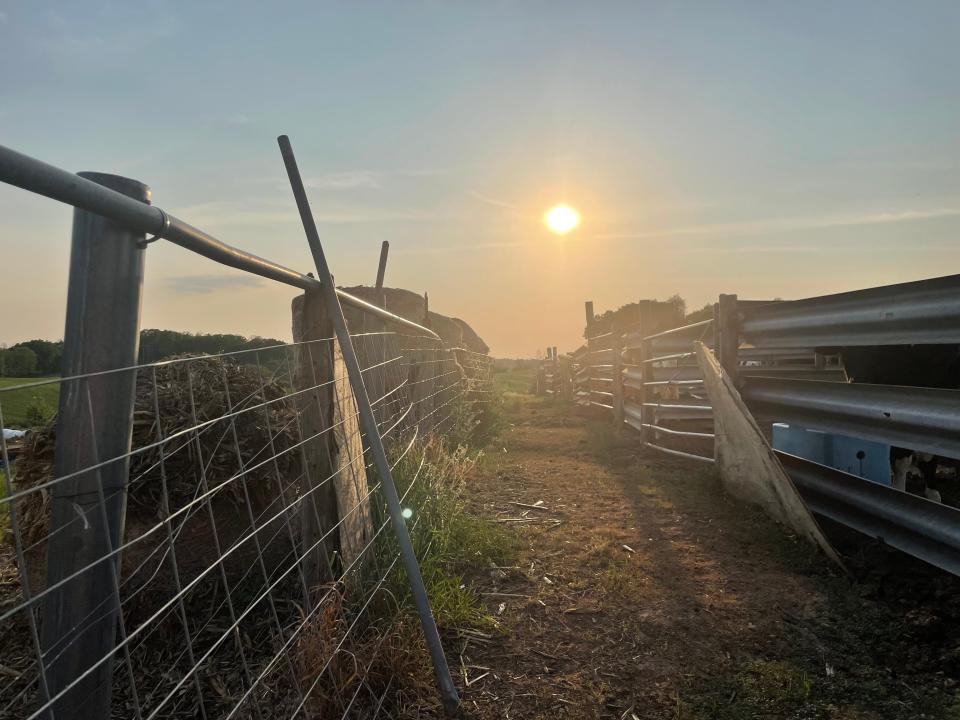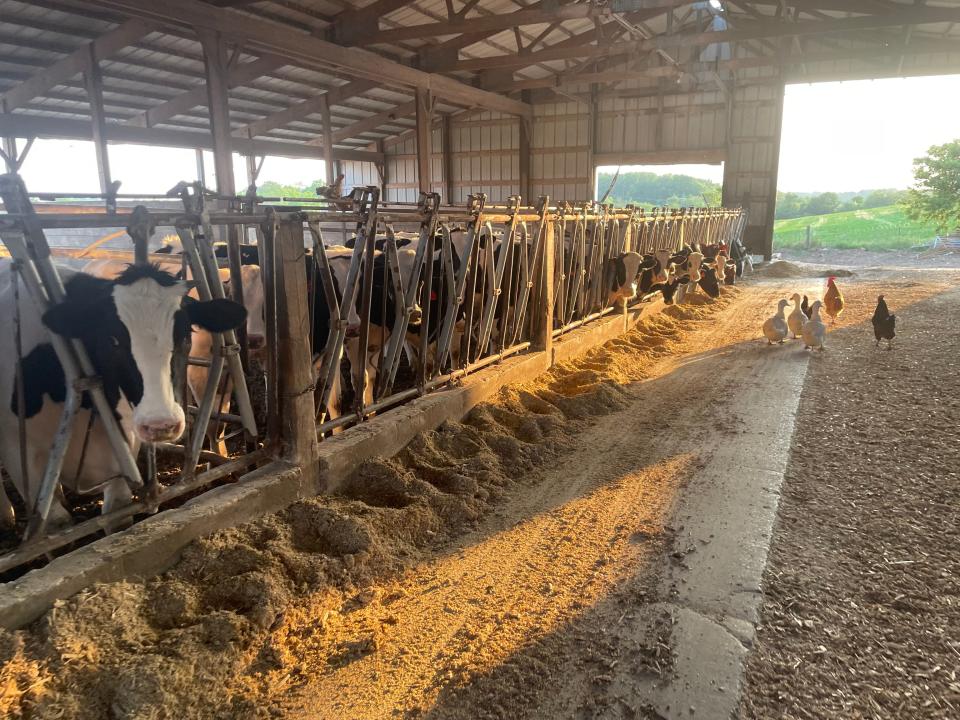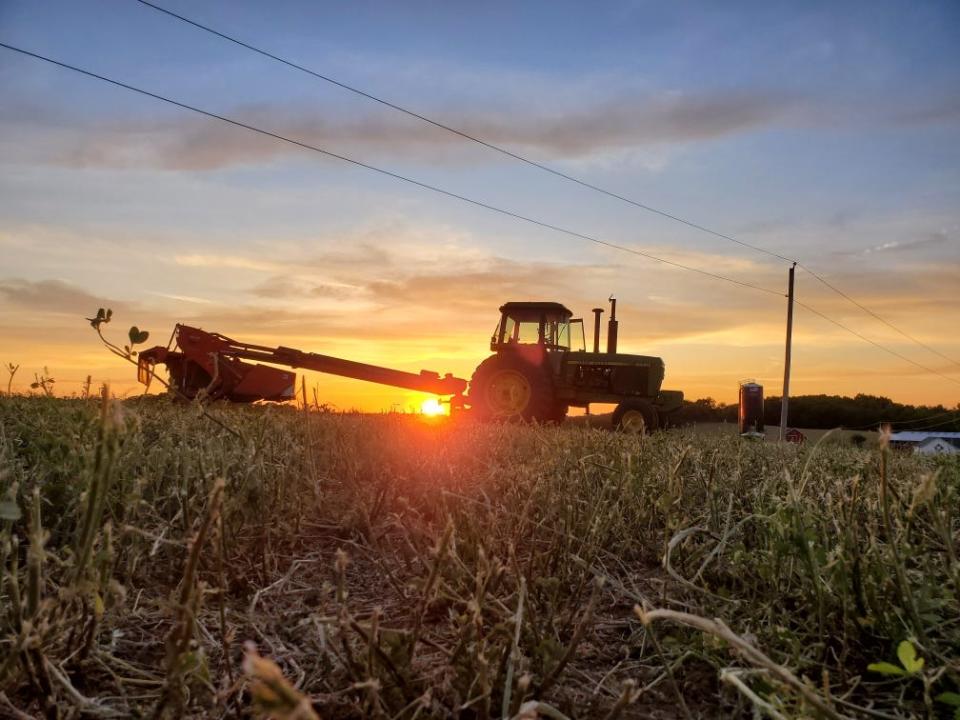Fighting a fire and odds against survival for Wisconsin family farms
My sister was down by the calf barn when she looked up the hill and saw the fire. The flames were already 5-feet high, dancing atop a corn stalk bale they’d swallowed, one of more than 100 highly flammable bales stacked in front of the loafing shed where we kept dozens of cattle. And all of it — the cattle and the bales and the fire — was just feet away from our farm’s three gas tanks, ready to blow.
Malia was pregnant with her fifth child, but you wouldn’t have known it by how quickly she jumped into the side-by-side Kubota utility vehicle and sped toward the flames. Along for the ride were three fire extinguishers, and knowledge of exactly what could happen.
“Paxton was still with me,” she remembered thinking of her 6-year-old son before she leapt from the side-by-side to fight the fire. “So I had to park the Kubota far enough away to keep him safe.”

If this seems like something most people wouldn’t do, running toward flames, it’s something that for my sister is part of our way of life. And it’s these moments that represent the crisis of disappearing farms across rural America. While so many farms are ground into the dust by hard economics and other forces, there is often a personal tragedy that actually drives them under. A herd of animals dead, or a crop lost. A family member sick. God forbid, an accident.
Or a fire.
Living the crisis of Wisconsin’s disappearing family farms
According to survey data released this year by the U.S. Department of Agriculture, Wisconsin lost another 8 percent of its farms from 2012 to 2022, topping the nationwide loss of 5 percent. And that drop, part of a trend that bounces around year-to-year but maintains its general downward spiral, is just the latest chapter in a decades-long loss. In the past generation, America has lost about 85 percent of our country’s dairy farms. Farms that long drove Wisconsin’s economy, and still define our identity.
Learn more about the plight of Wisconsin farms: Dairyland in Distress
The day of the fire, Malia, 34, wasn’t thinking about the trends in global economics, technology or society that have left farms on the edge. She was thinking of the steer with its head stuck in a gate. In order to keep the poor thing from choking, she used a cutting torch to slice through the gate. Afterwards, she checked spots where sparks could have flown.
Last October, we were in a vulnerable transition to keep our farm, with my dad still owning it and my sister taking over with a new business model. That's when a little spark from the cutting torch slipped into a corn stalk bale and began to smolder.
Our farm milked cows for over 100 years, until ongoing economic changes left a small operation like ours — just 50 cows — too small. We either needed to get bigger as my sister prepared to take over the farm from my dad, Jim, or find another business model. Luckily for us, our parents had never taken out large amounts of debt, so we were able to sell our herd and transition to Malia’s plan to raise heifers for other dairy farms, beef for consumers, and cash crops for the open market.

“Luckily we’re hanging on to what we have,” my dad said. “It’s downright tough. But that’s what we’re doing.”
Other farms haven’t had that shot. Rising input costs — seed, fertilizer, feed, fuel, electricity, and more — alongside a milk price that hasn’t kept pace have made it harder for all dairies, especially small ones like ours, experts and industry advocates agree. Many farms along the way borrowed to expand or make ends meet, and if they didn’t emerge more successful, they folded. Technology has also been geared toward helping farms get to a larger scale with less reliance on scarce labor, which, in turn, actually, has driven consolidation further and faster, according to Jim MacDonald, an agriculture researcher at the University of Maryland.
Succession issues are the hardest for me to admit. Many farmers sell for lack of someone to take over as their kids find economic opportunity elsewhere, and I’m an example of that. Short on talent for tractors and cattle, I pursued a career off the farm. I never lost my love for where I grew up, and years later I’ve found ways to help on the business side, and share our story. But the simple fact is, if my sister didn’t have what I lacked, we may have sold long ago.
That hard mix of economic and social trends leaves farms with very little room for error, said Pam Jahnke, a Wisconsin broadcaster who farmers have trusted on commodity prices and agriculture trends for decades.
“Agriculture today is not for somebody who just has a passing interest,” Jahnke said. “You have got to have your eye on the ball at all times.”
That’s why when my sister saw those flames up the hill, nobody had to tell her what hung in the balance. She was living it.
Fighting a fire, struggling with impact of losing farms in Wisconsin

It didn’t take long for Malia to know she couldn’t stop the fire. It was rising out of the bale and spreading, too big to knock down as she emptied one fire extinguisher after another. A hot wind whipped the inferno onward, blowing the fire extinguisher blasts back into her face. The air tasted salty, and wreaked of smoke.
“My only goal,” she said, “was to knock it away from the gas tank.”
With the fire still raging, Malia called 911. Then she ran around the back of the loafing shed to move the animals as far from the flames, smoke, and possible explosion as she could. She called our parents, away on a rare long weekend, and contacted me and others she felt should know, or could help. Then all she could do was return to the Kubota with Paxton as the flames overtook more bales.
It's those moments — the quiet amid the crisis — when the emotion rushes in and sparks questions, "What if something had happened?”
Of all the things she said, her voice careful as she unpacked the emotions of the day recently, those words held more meaning than most things most people say. Not only what if something happened to her, what if something had happened with her little boy watching? And what if the animals or loafing shed were lost, or the barn and house and onto the fields. What if it was all too much to keep going?
That would have meant my sister’s living, our parents’ retirement, our family home, our land, and the physical bond with over 100 years of farming heritage. My parents have faced those moments as well: dry weather destroying crops their first-year farming together, herd-wide sickness, two-dozen animals dead from a feeding mishap, and more.
It’s this kind of pressure — to save not just a job, but a way of life — that has fueled farm country’s mental health crisis. Michael Perry, the national bestselling author who grew up on a Wisconsin farm, felt so strongly about the human cost of such loss that he wrote his most recent book about it, the novella “40 Acres Deep.” Though he’s careful to note every person’s situation is different, Perry said the same resilience that enables farmers to carry on through hard times can make it tough to talk about mental health issues.

“You just didn’t complain, you buckled down,” he said. “It’s just about, ‘Get out there and get the chores done.’”
As the mental toll that comes from our disappearing farms becomes better known, so too are the other losses: economic, ecological, cultural, and more.
If a five-generation family operation like ours carries a special weight, it also offers its own redemption. On that day, it came from my nephew. Paxton had shown a rare streak of obedience, listening to his mother’s stern warning that he not leave the Kubota. Whenever she returned to him from fighting the fire, he’d pipe up with wisdom he’d learned in school.
“Mom, call 9-9-1!”
“Stop, drop, and roll!”
(No, 9-9-1 is not a typo. And no, my sister never caught fire. You can’t expect a 6-year-old to watch out for his mom, and share everything he knows about fire, and make sure she gets everything exactly right on top of it all, can you?)
Waiting with Paxton for the fire department, Malia hugged him and felt the tears surface.
Farmland spirit gives hope, even in darkest times
When I arrived, fire trucks lined the farmyard and firefighters were hitting the flames with the hose.
I’d driven my pickup from work at speeds I don’t care to disclose, weaving between vehicles and bombing through curving roads, not really knowing, based on a few frantic texts and calls, how bad the fire was, or whether my sister was really OK. When I finally saw Malia, she looked tired but resolute. She put me to work, using our skid steer to haul piles of soaked corn stalks out into the field as the firemen fought ever deeper into the fire.
By the time it was under control, over 100 bales had been hosed and torn apart across the farmyard. The Plain Fire & EMS, and Spring Green and Lone Rock fire departments, all volunteers, had responded. The Sauk County Sheriff’s Department stopped to assist. The Plain fire chief’s wife had brought food. A local backhoe operator worked tirelessly, driving his rig into the fire to break up the flaming bales while the firefighters hosed his machinery down to keep it cool.
Our neighbor had volunteered his manure spreader, so we could spread the extinguished corn stalk bales on our fields quicker. And when the Department of Natural Resources came (believing from inaccurate scanner chatter that the fire posed a risk beyond our farmyard) the local firefighters raised hell, making clear the fire was ruled accidental, under local jurisdiction.
When they were all gone after dark, I sat alone in the farmhouse. My parents were still gone and my sister was with her family. It was my job to check the pile of corn stalks overnight, several feet high and spanning much of the farmyard like the rubble from an explosion, to make sure none of it caught flame. So I sat there, and thought about what our community, after losing so many of its local farms for years, had shown us.
More essays from Brian Reisinger: Wisconsin's rural drug addiction crisis through the eyes of a childhood friend in our hometown
We’d grown up hearing about the old days, when farmers would band together for the harvest until the work was done. When families took in the children of relatives who couldn’t feed them in the Depression. Those days may be gone, but that farmland spirit was still alive, in the firefighters, paramedics, friends and neighbors.
If we haven’t lost that unique spirit — the blend of rugged individualism it takes to carve your living out of the ground, and sense of community it takes to come running when a neighbor is in trouble — then there’s hope. And where there is hope there is capacity for solutions, even against the forces driving so many of our farms under.
For a good month after, my sister felt the angst of that day any time she smelled smoke. I told her some people might say she’s a hero for saving our farm. To me she’s one that day, and every day for carrying our farm forward. My dad put it this way: “She’s a good, true farmer.”
To Malia, it’s not about her at all.
“In the end, I’m really happy that that steer was safe.”
Brian Reisinger is a writer who grew up on a family farm in Sauk County. He contributes in-depth columns and videos for the Ideas Lab at the Journal Sentinel. Reisinger has written for a wide range of publications and tells the hidden stories of rural America, including the drug crisis, past and future of Wisconsin farmers and adventures in the outdoors. Reisinger works in public affairs consulting for Wisconsin-based Platform Communications. He splits his time between a small town in northern California near his wife’s family, and his family’s farm here in Wisconsin. Reisinger studied journalism and political science at the University of Wisconsin-Eau Claire, and has won awards from the National Society of Newspaper Columnists, Seven Hills Review literary magazine, Wisconsin Newspaper Association, and more.
This article originally appeared on Milwaukee Journal Sentinel: Loss of Wisconsin farms continues to outpace national rate of folding.
